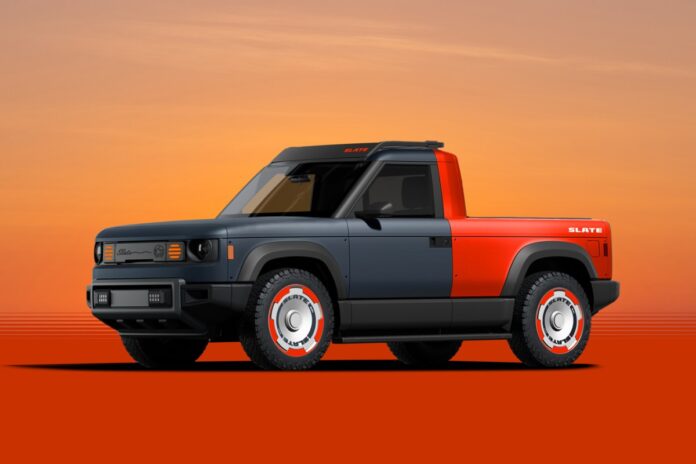A new American electric vehicle startup called Slate Auto has made its debut, and it’s about as anti-Tesla as it gets.
It’s affordable, deeply customizable, and very analog. It has manual windows and it doesn’t come with a main infotainment screen. Heck, it isn’t even painted. It can also transform from a two-seater pickup to a five-seater SUV.
The three-year-old startup revealed its vehicle during an event Thursday night in Long Beach, California, and promised the first trucks would be available to customers for under $20,000 with the federal EV tax credit by the end of 2026.
The event comes just a few weeks since TechCrunch revealed details of Slate Auto’s plans to enter the U.S. EV market, build its trucks in Indiana, and that the enterprise is financially backed by Amazon founder Jeff Bezos.
The auto industry “has been so focused on autonomy and technology in the vehicle, it’s driven prices to a place that most Americans simply can’t afford,” chief commercial officer Jeremy Snyder said during the event, which Inside EVs livestreamed. “But we’re here to change that.”
“We are building the affordable vehicle that has long been promised but never been delivered,” CEO Chris Barman added.
Slate isn’t saying exactly how much its truck will cost — multiple sources have told TechCrunch over the last few weeks the company has gone back and forth on the number. And so much can change between now and a late 2026 release date.
Techcrunch event
Berkeley, CA
|
June 5
BOOK NOW
The company is saying it will start under $20,000 after the federal tax credit (providing that still exists next year). Interested buyers can place a $50 refundable reservation on the company’s website.
The base version of Slate’s truck will squeeze 150 miles out of a 52.7kWh battery pack, which will power a single 150kW motor on the rear axle. For folks who get a little spooked at that number, Slate is offering a larger battery pack that it says will have about 240 miles of range. It will charge using a North American Charging Standard port, the standard Tesla established that almost all major automakers now use.
The truck comes with 17-inch wheels and a five-foot bed, and has a projected 1,400-pound payload capacity with a 1,000-pound towing capacity. Since it’s an EV, there’s no engine up front. In its place there’s a front trunk (or frunk) with 7 cubic feet of storage space, which happens to have a drain in case the owner wants to fill it with ice for that tailgate party.
That towing capacity is lower than a more capable Ford F-150, and is even less than the smaller Ford Maverick, which can tow around 1,500 pounds.
Speaking of the Ford Maverick, Slate’s truck is smaller. The Slate EV has a wheelbase of 108.9 inches, and an overall length of 174.6 inches. The Maverick has a 121.1-inch wheelbase and overall length of 199.7 inches.
Everything else about the base version of the truck is awfully spare — and that’s the point. Slate is really maximizing the idea of a base model, and setting customers up for paying to customize the EV to their liking.
Slate is deeply committed to the idea of customization, which sets it apart from any other EV startup (or traditional automaker).
The company said Thursday it will launch with more than 100 different accessories that buyers can use to personalize the truck to their liking. If that’s overwhelming, Slate has curated a number of different “starter packs” that interested buyers can choose from.
The truck doesn’t even come painted. Slate is instead playing up the idea of wrapping its vehicles, something executives said they will sell in kits. Buyers can either have Slate do that work for them, or put the wraps on themselves.
This not only adds to the idea of a buyer being able to personalize their vehicle, but it also cuts out a huge cost center for the company. It means Slate won’t need a paint shop at its factory, allowing it to spend less to get to market, while also avoiding one of the most heavily regulated parts of vehicle manufacturing.
Slate is telling customers that they can name the car whatever they want, offering the ability to purchase an embossed wrap for the tailgate. Otherwise, the truck is just referred to as the “Blank Slate.”
As TechCrunch previously reported, the customization piece is central to how the company hopes to make up margin on what is otherwise a relatively dirt-cheap vehicle.
But it’s also part of the friendly pitch Slate is making to customers.
Barman said Thursday that people can “make the Blank Slate yours at the time of purchase, or as your needs and finances change over time.” It’s billing the add-ons as “easy DIY” that “non-gearheads” can tackle, and says it will launch a suite of how-to resources under the billing of Slate University.
“Buy your accessories, get them delivered fast, and install them yourself with the easy how-to videos in Slate U, our content hub,” the website reads. “Don’t want to go the DIY route? A Slate authorized partner can come and do it for you.”
The early library of customizations on Slate’s website range from functional to cosmetic. Buyers can add infotainment screens, speakers, roof racks, light covers, and much more.
The most significant are the options that let buyers “transform” the truck into roomier SUV form factors. But these aren’t permanent decisions. Slate says people will be able to change their vehicle into, and back from, an SUV if they like — “no mechanics certification required.”
All that said, Slate’s truck comes standard with some federally mandated safety features such as automatic emergency braking, airbags, and a backup camera.
The road to making a successful American automotive startup is littered with failures. In the last few years, Canoo, Fisker, and Lordstown Motors have all filed for bankruptcy. And that’s just to name a few. Those companies that are still around, like Rivian and Lucid Motors, are hemorrhaging money in an attempt to get high-volume, more affordable models to market.
Slate is a total inversion of that approach. It’s going after a low-cost EV first and foremost, and hopes to make that business viable by supplementing it with money from this deep customization play.
But, much like Rivian and Lucid Motors, it also has deep-pocketed backers. It has raised more than $111 million so far (the exact figure is still not public). And, aside from Bezos, has taken money from Mark Walter, Guggenheim Partners CEO and controlling owner of the LA Dodgers, as TechCrunch reported this month.
The company has hired nearly 400 employees in service of accomplishing all of its ambitious goals, and is currently trying to hire more. Slate arguably could not have picked a more volatile time to make its debut, but it’s also focused on domestic manufacturing, and may be insulated from some of the turmoil facing other startups and established automakers.
“We believe vehicles should be affordable and desirable,” Barman said Thursday, adding that Slate’s truck “is a vehicle people are actually going to love and be proud to own.”


